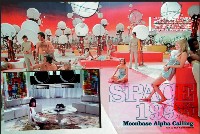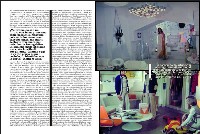Vogue Italia
The April 2011 edition of Vogue Italia contained a four page article on Space: 1999. The article, "Moonbase Alpha Calling" by Jan Kollerstrom, appears on pages 120-123 of the supplement CASA VOGUE ("Vogue home", focusing on interior design). Pages 120-121 is a double page spread showing the Alphans on planet Piri; the text appears on one page only.


The article states that the series has a unique style with "steely minimalism of the 1970s" created with furniture and objects of Italian design. "The design is not a decorative element, but the protagonist itself." "The series is an authentic sample-book of our best design of those years". It describes how Catherine Bujold collected many items of furniture (Catherine's site was Sorellarium13, although they actually credit space1999.net here).
The article describes how the partition walls could be assembled or dismantled like Lego. Keith Wilson is quoted "The Moonbase would be what we imagined as the future: clinical, antiseptic, minimal. No colour except white could express this." The alien worlds were baroque, colourful and psychedelic in contrast to contained and icy habitat of the Alphans. Wilson is quoted "Being able to unleash my imagination, I recycled what came to hand, especially objects from discarded plastic foundries. Everything unusual I could find, I used it. In that sense, I think I was a pioneer of recycling and sustainability."
The article ends with a quote from Keith Wilson (also the pull-quote): "We wanted to create a future we imagined was possible. No one could guess what it would be, but many later became iconic details. Somehow we have traced the style of those years. Today when people think of that time, they identify with the series." It concludes with a quote from Catherine Bujold: "this design will always remain timeless and always evoke a future that I'm still looking for."
It sometimes happens that a style dictates the story, and not vice versa. This is the case of the British television series of 1975-77 Space: 1999, created by Gerry Anderson after having renounced in 1970 a chance to develop the sequel to his other cult TV series, UFO. Produced by Britain's ITC (and for the first season by RAI), Space: 1999 was developed in record time, and in just a few years it was being broadcast all over the world, becoming the object of cult worship whose fans still keep it alive today. Two seasons, 48 episodes, two main characters played by Martin Landau and Barbara Bain, respectively Commander John Koenig and Dr. Helena Russell, a plot that situates the Alpha Base on a moon which, knocked out of the Earth's orbit by exploding nuclear waste sites, drifts toward unknown universes.
Apart from the story, the series works because of its unique and distinctive style, that of the rigid minimalism of the '70s which, thanks to furniture and objects largely of Italian design, expresses the surgical-metaphysical atmosphere that characterizes every episode. Design here is not a decorative element, but a genuine protagonist, coordinated by English set designer Keith Wilson, accompanied by - only in the first season, when the series had not yet been adjusted to the more American tastes of new producer Fred Freiberger, who geared the show more toward action and colour, reducing the metaphysical content - the famous cream-coloured jumpsuits worn by the Alphans, designed by Rudi Gernreich, inventor of unisex and creator, in the mid-60s, of the monokini and the thong. A design that dictates attitudes and situations through drastic means such as flat light, a limited chromatic range (cream, gray, white) and the curved lines of the furniture, rigorously of white plastic, ordered specially from Italy.
The series is a veritable sample book of the best Italian design of the period, which collector Catherine Bujold has been tracking down since 1994 with the aim of creating an Alpha Base in her Montreal home with the eighty or so objects and furniture items depicted in the TV show. "An oasis of Modernism," she calls it, adding key pieces to the collection year after year. "The first piece was the 'Sorella' lamp by Harvey Guzzini. Then, with help from the Internet, I managed to put together the fundamental furniture items to make my home into an Alphan space: two chairs and a table from Habitat '67 (the section dedicated to design at Montreal's Expo '67, ed.), an original 'Elda' chair by Joe Colombo from 1968, a 'Giano Vano' table from Artemide, four 'Selene' chairs and nine more 'Sorella' lamps, which took me until 2004. Then I found a 'Ribbon' chair from Artifort and the 'Unibloc 4' by Steiner, a stool by Nana Ditzel, a 'Pileo' lamp, the 'Lucciola' by Guzzini and lots of other lamps from the '60s and '70s. Light is everything in Space: 1999 - the source of warmth and life, in nature as in a synthetic universe."
And light was also the base element for Keith Wilson, who, needing to create new alien worlds for every episode in just two weeks, invented a system of partition walls made of panels that functioned like Lego, which were not only easy to assemble and dismantle, but also became a trademark of the Alpha Moonbase: smooth, sliding (like the round-cornered doors), covered in white plastic, off of which Wilson reflected a flat, cold, uniform light. "I had to create a world that had never been seen, and the moonbase had to be what we then imagined the future to look like: clinical, aseptic, minimal. No colour except white could have communicated all this."
A future that Keith Wilson, hypothesizing a sequel for the story of the vagabonds of the universe, imagines it differently from his original creation. "From the historical point of view, the Alphans would have been living on the base for many years. In that case, it would have to be more disorderly, not so clinical, with all kinds of junk strewn about, more like the lifestyle of the aliens. Lived in."
While Catherine Bujold has the hard, pure eye of the connoisseur, Keith Wilson has the voice of the artist who truly appreciated the freedom he was given by Anderson to invent monsters and alien worlds as he pleased. More often than not they were as baroque, colourful and psychedelic as the Alphans themselves and the lines of their habitat were restrained and frigid. "Limited only by the budget, I had a free hand to invent the world of the aliens however I wanted. With this license to unleash my imagination, I recycled whatever I could find, especially fragments and unused objects from plastic foundries. Anything I could find that was unusual, I would use it. In that sense, I suppose I was a pioneer of recycling and sustainability."
It was not, however, the flair of the aliens but rather the slick plastic world of the Alpha base that transformed the series into what Wilson describes as an original icon. In his view, only Kubrick was able to create something similar in 2001: A Space Odyssey. The difference is that the design in Kubrick remains in the background, even with iconic objects like the "Djinn" chair by Olivier Mourgue, whereas in Space: 1999, style is the catalyst for everything else. "We wanted to create a future that could be possible. No one could have guessed what it would be, but many details eventually became an iconographic patrimony. This had never happened before. In a sense, we documented the style of those years. When people today think of that period, they identify it with the series." A period that doesn't age, certainly not for Catherine Bujold, who lives her daily life with these objects, and for whom "this design will always remain timeless, and will always evoke a future that I'm still waiting for."
Jan Kollerstrom